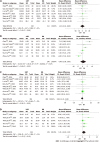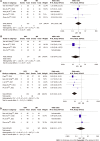Comparison between laparoscopic uncut Roux-en-Y and Billroth II with Braun anastomosis after distal gastrectomy: A meta-analysis
- PMID: 35979420
- PMCID: PMC9258235
- DOI: 10.4240/wjgs.v14.i6.594
Comparison between laparoscopic uncut Roux-en-Y and Billroth II with Braun anastomosis after distal gastrectomy: A meta-analysis
Abstract
Background: Conventional Billroth II (BII) anastomosis after laparoscopic distal gastrectomy (LDG) for gastric cancer (GC) is associated with bile reflux gastritis, and Roux-en-Y anastomosis is associated with Roux-Y stasis syndrome (RSS). The uncut Roux-en-Y (URY) gastrojejunostomy reduces these complications by blocking the entry of bile and pancreatic juice into the residual stomach and preserving the impulse originating from the duodenum, while BII with Braun (BB) anastomosis reduces the postoperative biliary reflux without RSS. Therefore, the purpose of this study was to compare the efficacy and safety of laparoscopic URY with BB anastomosis in patients with GC who underwent radical distal gastrectomy.
Aim: To evaluate the value of URY in patients with GC.
Methods: PubMed, Embase, Web of Science, Cochrane Library, Chinese National Knowledge Infrastructure, Wanfang, Chinese Biomedical Database, and VIP Database for Chinese Technical Periodicals (VIP) were used to search relevant studies published from January 1994 to August 18, 2021. The following databases were also used in our search: Clinicaltrials.gov, Data Archiving and Networked Services, the World Health Organization International Clinical Trials Registry Platform Search Portal (https://www.who.int/clinical-trials-registry-platform/the-ictrp-search-portal), the reference lists of articles and relevant conference proceedings in August 2021. In addition, we conducted a relevant search by Reference Citation Analysis (RCA) (https://www.referencecitationanalysis.com). We cited high-quality references using its results analysis functionality. The methodological quality of the eligible randomized clinical trials (RCTs) was evaluated using the Cochrane Risk of Bias Tool, and the non-RCTs were evaluated using the Newcastle-Ottawa scale. Statistical analyses were performed using Review Manager (Version 5.4).
Results: Eight studies involving 704 patients were included in this meta-analysis. The incidence of reflux gastritis [odds ratio = 0.07, 95% confidence interval (CI): 0.03-0.19, P < 0.00001] was significantly lower in the URY group than in the BB group. The pH of the postoperative gastric fluid was lower in the URY group than in the BB group at 1 d [mean difference (MD) = -2.03, 95%CI: (-2.73)-(-1.32), P < 0.00001] and 3 d [MD = -2.03, 95%CI: (-2.57)-(-2.03), P < 0.00001] after the operation. However, no significant difference in all the intraoperative outcomes was found between the two groups.
Conclusion: This work suggests that URY is superior to BB in gastrointestinal reconstruction after LDG when considering postoperative outcomes.
Keywords: Anastomosis; Conventional Billroth II; Gastric cancer; Laparoscopy; Meta-analysis; Uncut Roux-en-Y.
©The Author(s) 2022. Published by Baishideng Publishing Group Inc. All rights reserved.
Conflict of interest statement
Conflict-of-interest statement: The authors declare no conflicts of interest for this article.
Figures





Similar articles
-
Uncut Roux-en-Y might reduce the rate of reflux gastritis after radical distal gastrectomy: An evidence mapping from a systematic review.Int J Surg. 2022 Jan;97:106184. doi: 10.1016/j.ijsu.2021.106184. Epub 2021 Dec 1. Int J Surg. 2022. PMID: 34861427
-
Total Laparoscopic Uncut Roux-en-Y for Radical Distal Gastrectomy: An Interim Analysis of a Randomized, Controlled, Clinical Trial.Ann Surg Oncol. 2021 Jan;28(1):90-96. doi: 10.1245/s10434-020-08710-4. Epub 2020 Jun 18. Ann Surg Oncol. 2021. PMID: 32556870 Clinical Trial.
-
[Comparison of clinical efficacy and quality of life between uncut Roux-en-Y and Billroth II with Braun anastomosis in laparoscopic distal gastrectomy for gastric cancer].Zhonghua Wei Chang Wai Ke Za Zhi. 2022 Feb 25;25(2):166-172. doi: 10.3760/cma.j.cn441530-20210702-00257. Zhonghua Wei Chang Wai Ke Za Zhi. 2022. PMID: 35176829 Chinese.
-
Tranditional Roux-en-Y vs Uncut Roux-en-Y in Laparoscopic Distal Gastrectomy: a Randomized Controlled Study.J Gastrointest Surg. 2023 Jun;27(6):1098-1105. doi: 10.1007/s11605-023-05644-6. Epub 2023 Mar 14. J Gastrointest Surg. 2023. PMID: 36917403 Free PMC article. Clinical Trial.
-
Four reconstruction methods after laparoscopic distal gastrectomy: A systematic review and network meta-analysis.Medicine (Baltimore). 2019 Dec;98(51):e18381. doi: 10.1097/MD.0000000000018381. Medicine (Baltimore). 2019. PMID: 31860999 Free PMC article.
Cited by
-
Evaluating the safety of robotic total gastrectomy with D2 lymphadenectomy for gastric cancer against the conventional laparoscopic approach: a systematic review and meta-analysis.J Robot Surg. 2025 Feb 3;19(1):59. doi: 10.1007/s11701-025-02219-2. J Robot Surg. 2025. PMID: 39899136
-
Uncut Roux-en-Y reconstruction after distal gastrectomy for gastric cancer.Cochrane Database Syst Rev. 2024 Feb 29;2(2):CD015014. doi: 10.1002/14651858.CD015014.pub2. Cochrane Database Syst Rev. 2024. PMID: 38421211 Free PMC article.
-
Long-Term outcomes of uncut roux-en-Y anastomosis in laparoscopic distal gastrectomy: A retrospective analysis.Front Surg. 2023 Feb 22;10:1090626. doi: 10.3389/fsurg.2023.1090626. eCollection 2023. Front Surg. 2023. PMID: 36911600 Free PMC article.
-
Comparison of uncut Roux-en-Y anastomosis and Billroth-II with Braun anastomosis after distal gastrectomy.Front Surg. 2024 Mar 28;11:1390876. doi: 10.3389/fsurg.2024.1390876. eCollection 2024. Front Surg. 2024. PMID: 38605734 Free PMC article.
-
Robotic vs laparoscopic distal gastrectomy with Billroth I and II reconstruction: a systematic review and meta-analysis.J Robot Surg. 2024 Dec 19;19(1):30. doi: 10.1007/s11701-024-02193-1. J Robot Surg. 2024. PMID: 39699804
References
-
- Suh YS, Lee J, Woo H, Shin D, Kong SH, Lee HJ, Shin A, Yang HK. National cancer screening program for gastric cancer in Korea: Nationwide treatment benefit and cost. Cancer. 2020;126:1929–1939. - PubMed
-
- Bray F, Ferlay J, Soerjomataram I, Siegel RL, Torre LA, Jemal A. Global cancer statistics 2018: GLOBOCAN estimates of incidence and mortality worldwide for 36 cancers in 185 countries. CA Cancer J Clin. 2018;68:394–424. - PubMed
-
- Kitano S, Iso Y, Moriyama M, Sugimachi K. Laparoscopy-assisted Billroth I gastrectomy. Surg Laparosc Endosc. 1994;4:146–148. - PubMed
-
- Yakoub D, Athanasiou T, Tekkis P, Hanna GB. Laparoscopic assisted distal gastrectomy for early gastric cancer: is it an alternative to the open approach? Surg Oncol. 2009;18:322–333. - PubMed
LinkOut - more resources
Full Text Sources
Research Materials
Miscellaneous

